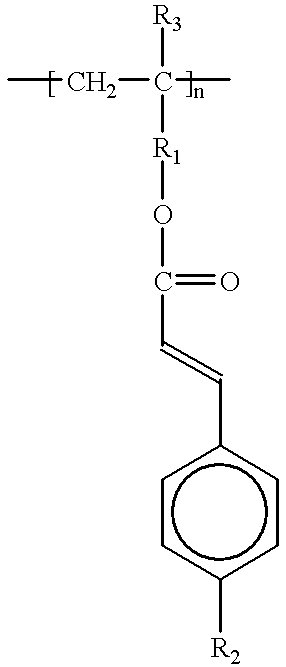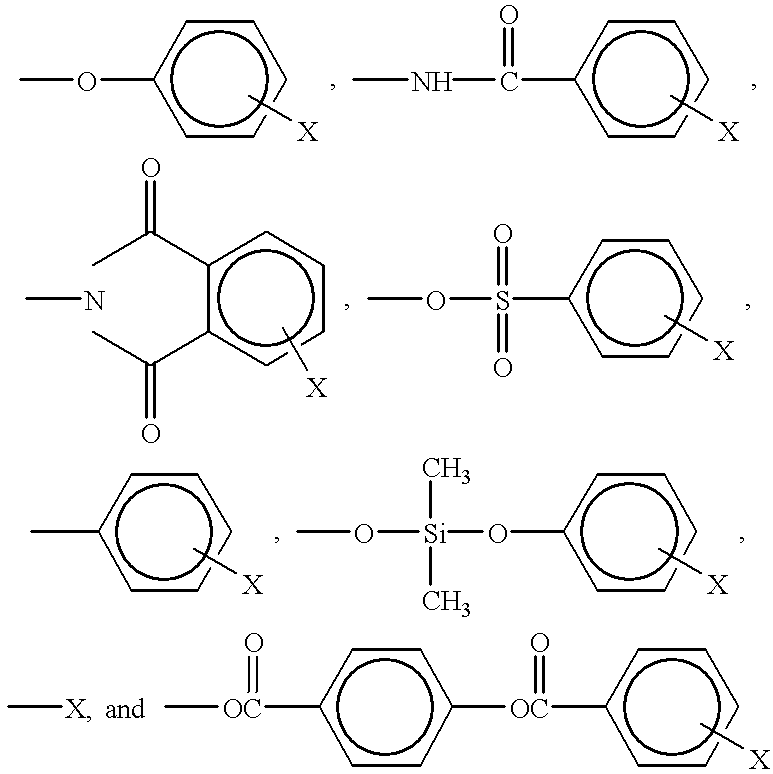Cinnamate-containing photopolymer for orientation film of liquid crystal display (LCD) and method for using the photopolymer to form an orientation film
- Summary
- Abstract
- Description
- Claims
- Application Information
AI Technical Summary
Benefits of technology
Problems solved by technology
Method used
Image
Examples
example i
Application to a TN Mode LCD
(1) Synthesis of cinnamate-containing side branch
Para-aminocinnamic acid hydrochloride (0.1 mol, 19.96 g) was dissolved in 100 milliliters (ml) of dimethylacetamide and 30 ml pyridine, then 0.1 mol of para-fluorobenzoylchloride was added dropwise while the solution was maintained at 0.degree. C. The solution was allowed to react for about 5 hours at room temperature, and then neutralized to a pH of 6 to 7 with hydrochloric acid. The solution was filtered to obtain a reaction intermediate. The intermediate was washed with water, dried under a vacuum and recrystallized in a solution of dimethylacetamide (10%) and water (90%). A yield of 90% N (para-fluorbenzoyl)-para-aminocinnamic acid in was obtained. Thionyl chloride (1.2 equivalents) and 50 ml of methylene chloride were added. The solution was allowed to react until clear. After the reaction, the solvent and thionyl chloride were removed under a vacuum, and the remaining product was dried. N-(para-fluorb...
example 2
Application to TN Mode LCD
(1) Synthesis of cinnamate-containing side branch
Para-aminocinnamic acid hydrochloride (0.1 mol) was dissolved in 100 ml of dimethylacetamide. Isoquinoline was added, then 4-fluorophthalic anhydride was added while the solution was maintained at room temperature. After reacting for 10 hours at 160.degree. C., the solution was poured into water and a solid intermediate was obtained. The intermediate was washed with water and then dried under a vacuum. The intermediate was recrystallized in dimethylacetamide. A yield of 90% of para(para fluorophthalimide) cinnamic acid was obtained. Thionyl chloride (1.2 equivalents) was added, followed by 50 ml of methylene chloride, while the solution was maintained at room temperature. The reaction was allowed to continue until a transparent solution was obtained. After the reaction, the solvent and thionyl chloride were removed under a vacuum and the remaining solid product was dried. Para(para-fluorophthalimide)-cinnamoy...
example 3
Application to IPS Mode
(1) Synthesis of mesogen-1 having cinnamate
To 100 ml of an aqueous solution of 0.2 mole (8 g) of sodium hydroxide and 100 ml of dimethylsufoxide 0.1 mole (16.42 g) of para-hydroxycinnamic acid was added. The resulting solution was maintained at 0.degree. C. and 0.1 mole (15.86 g) of para-fluorobenzoylchloride was added dropwise. The resulting solution was vigorously agitated. After reaction for two hours, the solution was neutralized with hydrochloric acid to a pH of 6 to 7. The solution was filtered and a solid intermediate was obtained. The intermediate was washed with water and dried under vacuum. The intermediate was recrystallized in ethanol to give para-fluorobenzoyloxycinnamic acid at a yield of 90%. To the para fluorobenzoyloxycinnamic acid, 1.2 equivalents of thionylchloride and 50 ml of methylene chloride were added at room temperature. The resulting solution was allowed to react until a clear solution was obtained. After reaction, the solvent and th...
PUM
| Property | Measurement | Unit |
|---|---|---|
| Fraction | aaaaa | aaaaa |
| Percent by mass | aaaaa | aaaaa |
| Angle | aaaaa | aaaaa |
Abstract
Description
Claims
Application Information
 Login to View More
Login to View More - Generate Ideas
- Intellectual Property
- Life Sciences
- Materials
- Tech Scout
- Unparalleled Data Quality
- Higher Quality Content
- 60% Fewer Hallucinations
Browse by: Latest US Patents, China's latest patents, Technical Efficacy Thesaurus, Application Domain, Technology Topic, Popular Technical Reports.
© 2025 PatSnap. All rights reserved.Legal|Privacy policy|Modern Slavery Act Transparency Statement|Sitemap|About US| Contact US: help@patsnap.com



